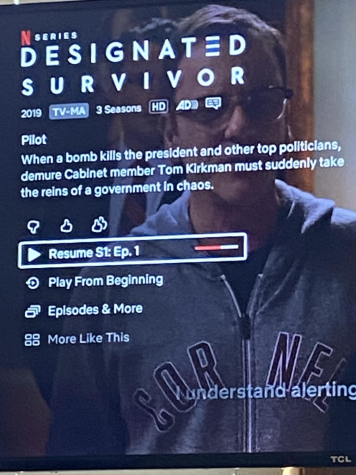The United States presidential line of succession
According to the Shapell Manuscript Foundation, the President of the United States of America has one of the most deadly jobs in the country. Statistically, the job is more dangerous than jobs such as construction and law enforcement. About 20% of presidents have died in office, 20% were targets of assassination attempts and 10% were assassinated. Because of the risk that comes with this job title, there are measures in place to make sure the country isn’t left without a leader.
The 25th Amendment was passed in Congress on July 6, 1965, and it was ratified on February 10, 1967. Section one of Amendment XXV states, “In case of the removal of the President from office or of his death or resignation, the Vice President shall become president.”
According to the official U.S. Senate website, “In 1791, a House committee recommended that this duty fall to the cabinet’s senior member—the secretary of state.”
Federalist senators disagreed because they didn’t want to see Secretary of State Thomas Jefferson, leader of the growing Anti-Federalist opposition, placed so close to the presidency. Others wanted the Senate President pro tempore. But this created conflict because they feared that the balance of the government branches would lead to an imbalance in power. The Chief Justice and the Speaker of the House of Representatives were also suggested, but no agreement could be reached. Congress decided to put this thought aside and visit it at a later date.
In the same publication it mentions that in 1792, the Second Congress passed the Presidential Succession Act. This act made the line of succession to be the Vice President, then the President Pro Tempore and finally the House Speaker. However, in 1886, Congress replaced the President Pro Tempore and speaker in the line of succession with the President’s cabinet members starting with the Secretary of State. This changed again in 1947 when Congress added the Speaker of the House and Senate President Pro Tempore ahead of the President’s cabinet.
What is the current line of succession?
The line of succession is the Vice President, Speaker of the House of Representatives, President Pro Tempore of the Senate, Secretary of State, Secretary of the Treasury, Secretary of Defense, Attorney General, Secretary of the Interior, Secretary of Agriculture, Secretary of Commerce, Secretary of Labor, Secretary of Health & Human Services, Secretary of Housing & Urban Development, Secretary of Transportation, Secretary of Energy, Secretary of Education, Secretary of Veterans Affairs and Secretary of Homeland Security.
Because all these people are in line for the presidency, they can’t all be in the same room as each other for safety measures in case of an emergency. For example, the Constitution on the official Senate website says, “[The President] shall from time to time give to the Congress Information of the State of the Union.” During the annual State of the Union address, everyone who is in the line of succession is expected to show up. However, one member of the President’s cabinet doesn’t attend because they are the designated survivor.
What is a designated survivor?
According to the Cox Media Group National Content Desk, “The designated survivor is a person that is chosen to be moved to a secure location, far away from the State of [the] Union address, in case of a catastrophic event.”
The designated survivor is used as a fail-safe in case the worst-case scenario occurs and mass casualties leave the U.S. without a leader.

The 2016 series Designated Survivor shows what would happen if a designated survivor were to become the president. In the show, Keifer Sutherland plays Tom Kirkman, the Secretary of Housing & Urban Development. During the State of the Union address, Kirkman is selected to be the designated survivor that night. However, when the capital building is bombed during the President’s speech, Kirkman is forced into the Commander in Chief’s position and is the new President of the United States.
If the fail-safe of a designated survivor didn’t exist, then in this situation, the United States government would be in troubled waters. Even though the country has never had to face a situation close to the circumstance in the show Designated Survivor, there have been cases where the Vice President had to take up the role of president.
Vice Presidents turned Presidents
According to the official Senate website, of the fifteen vice presidents who went on to become president, eight succeeded to the office on the death of a president. Of those eight that had to step into office, four of the presidents were assassinated.
First, Lincoln was shot in 1865, then in 1881, James A. Garfield died of complications with a gunshot wound. William McKinley was shot on Sept. 6, 1901, and he died a couple of days later. The most recent president to be assassinated was John F. Kennedy in 1963.
The National Archives released an article saying, “It was only after William McKinley was shot that systematic and continuous protection of the President was instituted.” In that same article, the eight attempts of assassinations on U.S. presidents were listed and it said, “Attempts have thus been made on the lives of one of every five American presidents. One of every nine presidents has been killed. Since 1865, there have been attempts on the lives of one of every four presidents and the successful assassination of one of every five. During the last three decades, three attacks were made.”
Because this job has had so many casualties and near casualties, it’s beneficial that the government has a system in place to prevent the possibility of no head of state.
What would happen if the current president died?
The current President of the United States is Joseph Biden. His Vice President is Kamala Harris. If Biden were to suddenly die in office, Harris would assume the position of U.S. President. If Harris wasn’t available to take the President’s position, then the next in line would be Speaker of the House Nancy Pelosi. This is Pelosi’s fourth term as Speaker of the House. She was also elected to be the first woman Speaker in 2007. However, after the 2022 midterm elections, Pelosi is not going after re-election, so the person who is elected to be the new speaker will take her place.
After Pelosi, the next person in line would be President Pro Tempore Patrick Leahy. He was President Pro Tempore from 2012 to 2015 and he was reelected to the title in 2021. According to a report from Fiscal Note published in February 2021, at the time, Leahy was the fifth oldest person serving in the Senate and the fourteenth oldest person in Congress.
The rest of the succession line is Secretary of State Antony Blinken, Secretary of the Treasury Dr. Janet Yellen, Secretary of Defense Lloyd Austin, Attorney General Merrick Garland, Secretary of the Interior Deb Haaland, Secretary of Agriculture Tom Vilsack, Secretary of Commerce Gina Raimondo, Secretary of Labor Marty Walsh, Secretary of Health & Human Services Xavier Becerra, Secretary of Housing & Urban Development Marcia Fudge, Secretary of Transportation Pete Buttigieg, Secretary of Energy Jennifer Granholm, Secretary of Education Dr. Miguel Cardona, Secretary of Veterans Affairs Denis McDonough and Secretary of Homeland Security Alejandro Mayorkas.
The U.S. will most likely never see any of these people as president in the near future. They are only in the line of succession as a precaution. However, if something ever happens in the future, the line of succession is mapped out and ready to go.

Name: Preslee Sutherland
Position: Web Assistant
Graduation year: 2025
A few sentences about me: I love reading...




